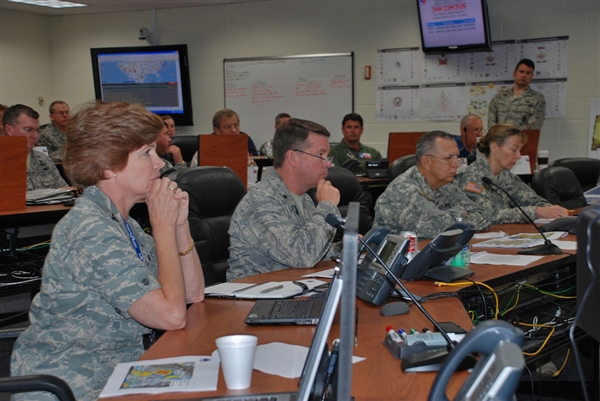WASHINGTON, May 9, 2012 — The Air Force has instituted measures designed to protect its pilots, ensure mission completion and assess the possible physiological effects of flying the F‑22 Raptor fighter aircraft, the command surgeon for Air Combat Command told reporters here today.
“The health and safety of our pilots — all of our pilots — is the utmost priority,” Air Force Brig. Gen. (Dr.) Daniel O. Wyman said. “Our operational flight surgeons and medical staff interact with our pilots on a daily basis, and mission No. 1 is their health and safety.”
Before resuming F‑22 flights in September 2011 after a safety stand-down, Wyman said, officials collected baseline blood samples and pulmonary function tests from every pilot.
“We had every pilot go through retraining with the reduced oxygen breathing device so that they would experience and know their own specific ‘hypoxia symptoms,’ he said, adding that the command also incorporated a pilot pulse oximeter and the C2A1 filter as protective measures.
Designed and certified by the Defense Department for the chemical warfare environment, Wyman said, the C2A1 filter canister was incorporated into the pilot’s life support system to filter any potential contaminants from the air they breathed. The filter has been tested against military and National Institute for Occupational Safety and Health protocols, and found to be effective against a number of different chemical warfare and industrial chemicals, Wyman said.
“It was cleared for flight use by the U.S. Air Force program office, and has been used by the military for over a decade in the ground crew and aircrew ensembles,” he added.
For each flight, the pilot would receive a new C2A1 filter consisting of a high-efficiency particulate, or HEPA, air filter and activated carbon and charcoal, Wyman said, and they turned in the filters at the end of each flight.
Once flying resumed, Wyman said, a black dust was found in some of the breathing hoses near the C2A1 filter.
“We analyzed it and found it to be activated carbon dust … an inert or nonreactive compound that has been used for air and water filtration for decades without any significant evidence of harm,” Wyman said.
Filter test results indicated the amount of activated carbon dust liberated during normal use was well below the industrial hygiene standard levels set by government agencies, the command surgeon said. Thirty pilot throat swab samples examined by electron microscope also indicated no evidence of activated carbon, he added.
Still, some Raptor pilots have reported suffering persistent coughing, which Wyman maintained may stem from high concentrations of oxygen while undergoing spiked G‑forces during maneuvering. These conditions, he said, may result in adsorption of the oxygen — adhesion of a small layer of molecules — and subsequent microcollapse of some of the small air sacs in the lungs.
“Coughing is a natural physiologic response that serves to re-inflate the air sacs,” Wyman said, noting the condition typically occurs following the flight and is brief in duration.
Air Combat Command has implemented a “recognize-confirm-recover” approach to fortify safety measures, Wyman said. In addition to training that helps ensure pilots can more readily recognize hypoxia or hypoxia-like symptoms, fliers can also pull an emergency oxygen ring, then descend to an altitude at which hypoxia would not occur, he said.
Wyman stressed that the command will continue to evaluate for other potential contaminates or environmental or aircraft system factors through the use of sensors and other collection devices. No root cause has yet been discovered, he said.
“Every step of the way during the F‑22 return-to-fly, we have worked with our pilots and all of our personnel involved to inspect the fleet, train the force, protect the crews and collect and analyze data,” Wyman said.
Source:
U.S. Department of Defense
Office of the Assistant Secretary of Defense (Public Affairs)

 von
von 